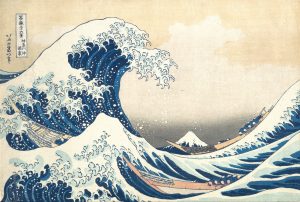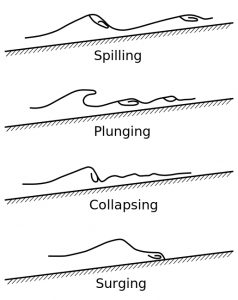This is the fifth installment of the “Science of the Shore Column" written by Bianca Charbonneau, Phd candidate. Have a science question you would like answered? Email Bianca at [email protected]
Christopher Candles famously said “The sea's only gifts are harsh blows, and occasionally the chance to feel strong.” Those harsh blows are waves and there are many ways to feel strong and weak in the face of them!
Waves are the propagation of energy through the water. Except for tsunamis, waves are the product of the wind (wind-driven or surface waves), specifically, wind speed, direction, and fetch (distance over which the wind blows in one direction over the ocean surface). As the wind blows over the water face, the water absorbs energy from that wind to create a wave; simply blow over a container filled with water and you will make ripples. A wave starts as ripples that gain energy to develop into chop and then becomes a waves over time; waves grow larger as they move through the water because once a ripple is created, there is greater surface area for the wind to interact with (wind stress), resulting in the ripple developing into chop and a wave of increasing size and speed. A wave increases in size quadratically relative to the wind speed and reaches its maximum size when it is traveling about as fast as the wind.
When you look at a wave, you are really only seeing about half of it. In the water below each wave are a number of eddy cells, circular motion of water molecules, stacked one on top of each other rotating in the direction of the wave movement; water molecules are spun in place without traveling with the wave and the energy is propagated along. A wave or swell could potentially travel across an entire ocean basin gaining energy in deeper water if unobstructed, but will break in shallower water.
As waves enter shallower water, the wave starts to ‘feel’ the bottom of the ocean. Friction with the ocean floor slows down the wavelength (distance between successive wave crests), but not wave period (the time between crests), which remains constant even at lower depths; waves also approach the shore at an angle as a function of interaction with the ocean floor. Waves will break at a depth of about 2/3 to 3/4 their height because at this depth, the speed of the wave crest is faster than the wave trough, and this instability causes the wave crest to crash.
There are four different types of waves based on break – spilling, plunging, collapsing, and surging. Spilling waves are the safest to swim in – the crest spills down the front of the wave as it breaks. Plunging are those that form the curl/tube/barrel that surfers dream of because the wave travels from deep to shallow water quickly and slows down rapidly. Surging waves do not crash or spill, but bulge up and then crash quickly at the shoreline. Collapsing waves are a cross between plunging and surging– the crest never fully breaks, but the bottom trough of the wave gets steeper and collapses to create foam.
Regardless of the wave type, always respect the ocean’s power!






